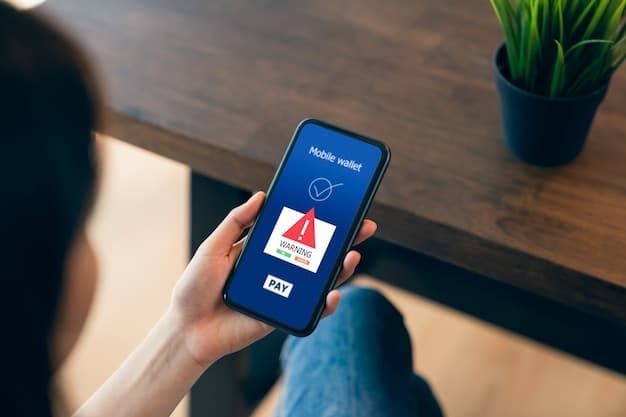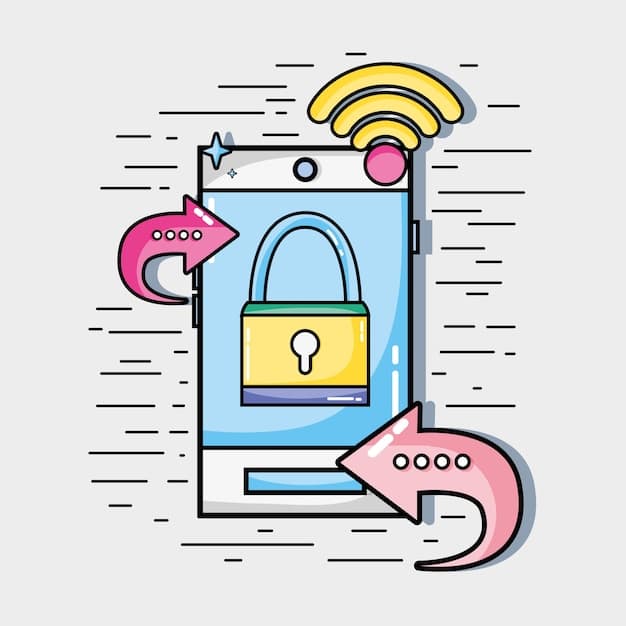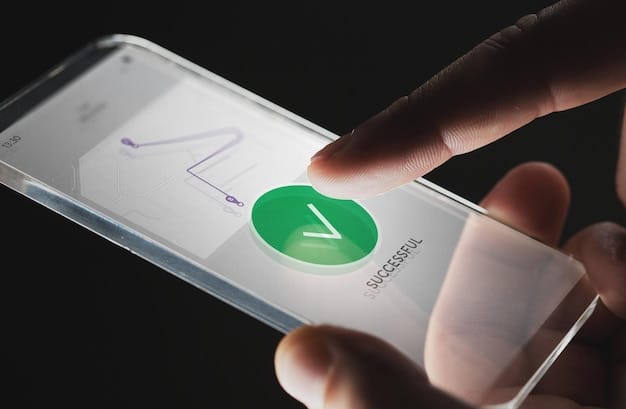Social Media Hacking Alert: Secure Your US Accounts Now!

An alert has been issued regarding a surge in social media hacking targeting users in the United States, emphasizing the urgent need for individuals to enhance the security of their online accounts to protect against unauthorized access and data breaches.
An urgent alert: Increase in social media hacking targeting US users – secure your accounts now. Cybercriminals are increasingly targeting social media accounts within the United States, making it more critical than ever to protect your online presence. Let’s take immediate action to secure your accounts and safeguard your personal information.
Understanding the Rising Threat of Social Media Hacking
Social media platforms have become integral parts of our daily lives, making them prime targets for cybercriminals. Understanding the scope and nature of these threats is the first step to protecting yourself.
Why Social Media Accounts Are Targeted
Social media accounts are targeted due to the vast amount of personal information they contain. This data can be used for identity theft, phishing scams, and other malicious activities.
Common Hacking Techniques
Hackers employ various techniques to compromise social media accounts, including phishing, malware, and brute-force attacks. Being aware of these methods can help you recognize and avoid them.
- Phishing: Deceptive emails or messages that trick users into revealing login credentials.
- Malware: Malicious software that steals information when a user clicks on a compromised link.
- Brute-Force Attacks: Automated attempts to guess passwords using common password combinations.
The rise in social media hacking underscores the need for heightened awareness and robust security practices. By understanding why these accounts are targeted and the techniques used, users can take proactive steps to protect themselves. It’s essential to remain vigilant and adopt strong security measures to mitigate the risk of falling victim to these cyber threats.

Strengthening Your Password Security
One of the most effective ways to protect your social media accounts is by using strong, unique passwords. Here’s how you can enhance your password security to thwart potential hackers.
Creating Strong Passwords
A strong password should be complex and difficult to guess. Avoid using personal information, common words, or predictable patterns.
Password Management Tools
Consider using a password manager to generate and store complex passwords securely. These tools encrypt your passwords and can automatically fill them in when you log in to your accounts.
- Use a Combination of Characters: Include upper and lower case letters, numbers, and symbols.
- Avoid Personal Information: Do not use your name, birthday, or other easily accessible information.
- Regularly Update Passwords: Change your passwords periodically to reduce the risk of compromise.
Strengthening your password security is a fundamental step in protecting your social media accounts. By creating strong, unique passwords and utilizing password management tools, you significantly reduce your vulnerability to hacking attempts. Regular updates and vigilance are key to maintaining a secure online presence.
Enabling Two-Factor Authentication (2FA)
Two-factor authentication (2FA) adds an extra layer of security to your social media accounts, making it significantly harder for hackers to gain unauthorized access. Here’s why and how to enable 2FA.
What is Two-Factor Authentication?
2FA requires you to provide a second form of verification in addition to your password, such as a code sent to your mobile device.
How to Enable 2FA on Popular Platforms
Most major social media platforms offer 2FA options. Here’s how to enable it on some popular platforms.
- Facebook: Go to Settings & Privacy > Security and Login > Use two-factor authentication.
- Instagram: Go to Settings > Security > Two-Factor Authentication.
- Twitter: Go to Settings and privacy > Security > Two-factor authentication.
Enabling two-factor authentication is a crucial step in securing your social media accounts. By requiring a second form of verification, you drastically reduce the risk of unauthorized access, even if your password is compromised. Ensure you activate 2FA on all platforms that offer it for maximum protection.

Recognizing and Avoiding Phishing Scams
Phishing scams are a common method used by hackers to steal social media credentials. Learning to recognize and avoid these scams is essential to protect your accounts.
Identifying Phishing Attempts
Phishing attempts often come in the form of emails or messages that appear to be from legitimate sources. Look for red flags such as poor grammar, urgent requests, and suspicious links.
Protecting Yourself from Phishing
Never click on suspicious links or provide personal information in response to unsolicited messages. Always verify the sender’s identity before taking any action.
- Check the Sender’s Email Address: Ensure the email address matches the official domain of the company.
- Beware of Urgent Requests: Phishing emails often create a sense of urgency to pressure you into acting quickly.
- Hover Over Links: Before clicking, hover over the link to see the actual URL. If it looks suspicious, do not click it.
Recognizing and avoiding phishing scams is crucial for maintaining the security of your social media accounts. By staying vigilant and verifying the legitimacy of communications, you can protect yourself from falling victim to these deceptive practices. Always err on the side of caution and never provide personal information in response to unsolicited requests.
Monitoring Account Activity and Reporting Suspicious Behavior
Regularly monitoring your social media account activity can help you detect unauthorized access or suspicious behavior early on.
Checking Login History
Most social media platforms provide a login history feature that allows you to see when and where your account has been accessed. Review this regularly to identify any unusual activity.
Reporting Suspicious Behavior
If you notice any suspicious activity, such as unrecognized logins or posts you didn’t create, report it to the social media platform immediately.
- Review Recent Activity: Check for posts, messages, or changes to your profile that you didn’t make.
- Monitor Connected Apps: Review and remove any third-party apps that you no longer use or recognize.
- Set Up Alerts: Enable notifications for new logins to receive immediate alerts about unauthorized access.
Monitoring account activity and reporting suspicious behavior are proactive measures that can help you protect your social media accounts from potential threats. Regularly reviewing your login history and connected apps allows you to detect and address any unauthorized access promptly. Reporting suspicious activity to the platform helps prevent further damage and protects other users as well.
Using Privacy Settings to Protect Your Information
Social media platforms offer a range of privacy settings that allow you to control who can see your posts, profile information, and activity. Configuring these settings correctly can significantly enhance your privacy and security.
Adjusting Privacy Settings
Take the time to review and adjust your privacy settings on each social media platform. Limit who can see your posts, control who can send you friend requests, and disable location tracking if desired.
Controlling Information Sharing
Be mindful of the information you share on social media. Avoid posting sensitive personal details that could be used for identity theft or other malicious purposes.
- Limit Post Visibility: Set your posts to be visible only to friends or specific groups.
- Control Friend Requests: Limit who can send you friend requests to prevent unwanted connections.
- Disable Location Tracking: Turn off location services to prevent your location from being tracked in your posts.
Using privacy settings to protect your information is an essential aspect of social media security. By carefully configuring these settings, you can control the visibility of your posts and profile information, limiting the exposure of sensitive data. Regularly reviewing and updating your privacy settings ensures that your personal information remains secure.
| Key Steps | Brief Description |
|---|---|
| 🔑 Strong Passwords | Create complex, unique passwords for each account. |
| 🛡️ Two-Factor Authentication | Enable 2FA for added security using a second verification method. |
| 🚨 Phishing Awareness | Recognize and avoid suspicious links and messages. |
| 🔒 Privacy Settings | Adjust privacy settings to control who sees your information. |
Frequently Asked Questions (FAQ)
▼
Social media accounts are targeted because they contain a wealth of personal information that can be used for identity theft, phishing, and other malicious activities.
▼
2FA adds an extra layer of security by requiring a second form of verification, such as a code sent to your phone, in addition to your password. It makes it much harder for hackers to access your account.
▼
Look for red flags such as poor grammar, urgent requests, suspicious links, and email addresses that don’t match the official domain of the company.
▼
Immediately change your password, enable two-factor authentication, review your account activity for unauthorized posts, and report the incident to the social media platform.
▼
It’s a good practice to update your social media passwords every three to six months to reduce the risk of password compromise.
Conclusion
Protecting your social media accounts from hacking requires vigilance and proactive measures. By implementing strong passwords, enabling two-factor authentication, recognizing phishing scams, and monitoring your account activity, you can significantly reduce your risk and safeguard your personal information in an increasingly digital world.





